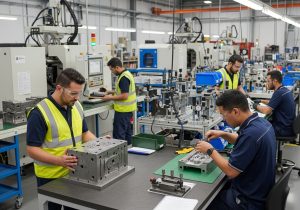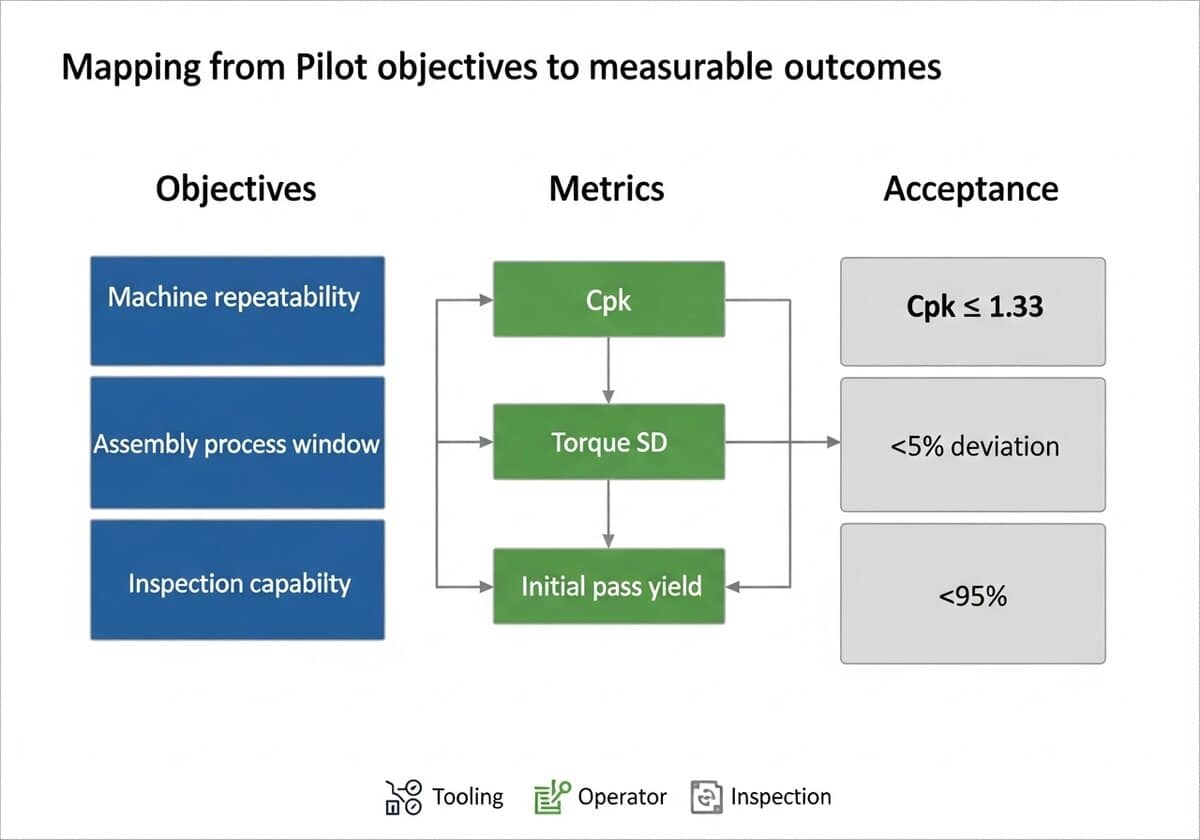كيفية التخطيط وتنفيذ تشغيل تجريبي للتحقق من صحة الأدوات وعمليات التجميع ومراقبة الجودة قبل الالتزام بالإنتاج الضخم.
يتطلب تحويل أداء النموذج الأولي إلى إنتاج قابل للتكرار تشغيلًا تجريبيًا منهجيًا يركز على التحقق من صحة عملية التصنيع بدلًا من تصميم المنتج. يُسلط التشغيل التجريبي المُنفذ بشكل صحيح الضوء على نقاط ضعف الأدوات، واختناقات التجميع، وفجوات مراقبة الجودة في ظل أوقات الدورة الفعلية وظروف التشغيل، مما يقلل من احتمالية إعادة العمل المكلفة عند بدء الإنتاج بكميات كبيرة.
ستجد في هذه المقالة نصائح لتحديد أهداف المشروع التجريبي، واختيار كميات وخطوط إنتاج المشروع التجريبي، وإعداد تدريب المشغلين، بالإضافة إلى منهجية قائمة على المقاييس لقياس إنتاجية المرحلة الأولى، وزمن الدورة، ومعدل الخردة، وكفاءة العملية. كما توضح اختبارات عملية للتحقق من صحة الأدوات، والقوالب، والتركيبات، وعمر القالب تحت أحمال الإنتاج، بالإضافة إلى خطوات منظمة لوضع اللمسات الأخيرة على تعليمات العمل، وخطط مراقبة الجودة، وإمكانية التتبع، والإجراءات التصحيحية بناءً على ملاحظات المشروع التجريبي.
النقاط الرئيسية

- تأكيد القدرة على التصنيع قبل الالتزام بالحجم
- تحديد حجم المشروع التجريبي وخط الإنتاج والمساحة والتدريب
- قياس FPY ووقت الدورة ووقت الدورة والخردة والقدرة
- قوالب اختبار الإجهاد والتجهيزات والأدوات للتآكل
- تعليمات العمل أثناء الإغلاق، وخطط التفتيش، وروابط التتبع
- استخدم بوابات الدخول/الخروج الرسمية وقوائم التحقق من الإصدار التنظيمي
- كن على دراية بمفاهيم PPAP وR@R
التحقق من صحة عمليات التصنيع وليس تصميم المنتج
Pilot objectives must target manufacturing process validation, not product concept checks.
حدد نتائج قابلة للقياس لإعداد المعدات، والالتزام بإجراءات التشغيل، وبوابات التفتيش. استخدم التشغيل التجريبي للتحقق من صحة الأدوات، وعمليات التجميع، ومراقبة الجودة قبل البدء بالإنتاج الضخم.
Set numerical targets up front, such as for example:
- الهدف هو قدرة العملية Cpk ≥ 1.33 للأبعاد الحرجة
- تقليل العيوب نحو إرشادات Six Sigma لـ 3.4 DPMO حيثما كان ذلك ممكنًا.
- حدد هدف العائد الأولي للنجاح (IPY) مثل ≥95% للتجميعات غير الحرجة.
- قم بتضمين معدلات الخردة المقبولة ونوافذ وقت الدورة المرتبطة بوقت الإنتاج.
تعريف وقت التاكت: في الإنتاج الخالي من الهدر، وقت الاختزال هو السرعة المحسوبة التي يجب أن يكتمل بها المنتج لتلبية طلب العميل. وهو بمثابة "القلب النابض" لعملية الإنتاج، حيث يعمل بشكل أساسي على مواءمة سرعة التصنيع مع معدل طلبات العملاء. يتم تحديد زمن الإنجاز بالصيغة البسيطة: [latex]\نص{وقت التكرير} = \frac{\نص{{إجمالي وقت الإنتاج المتاح}}{\نص{إجمالي طلب العملاء لتلك الفترة}}[/latex]. إن الهدف الأساسي من تحديد زمن التكرير هو مطابقة مخرجات الإنتاج مع متطلبات العملاء بشكل مثالي، وبالتالي تقليل الهدر من خلال الإنتاج الزائد أو الناقص وضمان سير العمل بسلاسة واستمرارية. هذا المقياس الرئيسي للتصنيع الخالي من الهدر ليس مقياسًا للوقت الذي يستغرقه إنتاج وحدة واحدة (أي زمن الدورة)، بل هو الإيقاع الذي يجب أن يحافظ عليه نظام الإنتاج للوفاء بالتزاماته.

أهداف العملية النموذجية:
- تأكيد إمكانية تكرار الآلة وفقًا لإيقاع الإنتاج.
- التحقق من صحة تسلسل التجميع ونوافذ عزم الدوران/القوة.
- إثبات إمكانية تكرار التفتيش والإنتاجية.
تصبح كل رصاصة اختبارًا منفصلاً بمعايير النجاح/الفشل وطريقة القياس.
استخدم أنظمة أخذ العينات والقبول المُعتمدة، مثل ANSI/ASQ Z1.4، لأخذ عينات الدفعات، وصنّف العيوب حسب شدتها الحرجة والرئيسية والثانوية. بالنسبة للعيوب الحرجة، اضبط مستوى الجودة المقبول (AQL) على 0؛ وبالنسبة للعناصر الرئيسية، اضبط مستوى الجودة المقبول (AQL) على 0.65-1.5 حسب درجة الخطورة. سجّل بيانات مدة التشغيل لدعم تقديرات Weibull أو تقديرات عمر الأدوات والتركيبات.
توزيع ويبل في التحقق من التصنيع: توزيع ويبل هو توزيع احتمالي مستمر يُستخدم على نطاق واسع في هندسة الموثوقية لنمذجة الفترة حتى تعطل أحد المكونات أو الأنظمة. تكمن قوته في مرونته، والتي تُحددها معاييره الرئيسية:
- معلمة الشكل (β أو k): هذه هي المعلمة الأكثر أهمية لأنها تشير إلى طبيعة معدل الفشل بمرور الوقت.
- β
- β = 1: يشير إلى معدل فشل ثابت، وهو سمة من سمات الفشل العشوائي أثناء العمر الإنتاجي للمنتج.
- β > 1: يشير إلى معدل فشل متزايد، مما يشير إلى فشل التآكل مع تقدم عمر المنتج.
- معلمة المقياس (η أو λ): يُعرف أيضًا باسم "العمر المميز"، ويمثل الفترة التي يُصاب فيها 63.2% من السكان بالفشل. وهو يُمدد أو يضغط التوزيع على طول محور الزمن.
- معلمة الموقع (γ): هذا المعامل الاختياري الثالث يُمثل فترة خالية من الأعطال. إذا كانت قيمته أكبر من الصفر، فهذا يُشير إلى فترة زمنية لا يُتوقع خلالها حدوث أي أعطال.
لمزيد من التفاصيل راجع مقالتنا المخصصة لهذا الموضوع:
اجمع مجموعة بيانات مُركّزة أثناء التجربة، وربطها بمقاييس القرار. يُلخّص الجدول أدناه عمليات الاقتران النموذجية.
| عملية | متري | قبول |
|---|---|---|
| حقن القالب | الأبعاد Cpk | ≥1.33 |
| عزم التجميع | انحراف عزم الدوران (SD) | ≤5% من نقطة الضبط |
| تقتيش | العائد الأولي للتمرير | ≥95% |
وثّق الأهداف وخطط القياس ومعايير الخروج في بروتوكول تجريبي مُوقّع من قِبل كلٍّ من جهة التصنيع والجودة. أدرج متطلبات التتبع وحقول البيانات المطلوبة لكل رقم قطعة مُجمّع.
نصيحة: تتطلب حدًا أدنى لطول التشغيل ينتج ما لا يقل عن 30 عينة مستقلة لكل خاصية حرجة لدعم تحليل القدرة الأساسية.
نصيحة: تأكد من قواعد شركتك وسلطة المجال الخاصة بك لمعرفة ما إذا كان يجب الاحتفاظ بعينات التحقق ومدة الاحتفاظ بها.

تخطيط التشغيل التجريبي

قم بتحديد عدد الدفعات التجريبية بناءً على أهداف التحقق والقيود اللاحقة؛ حيث تحدد ممارسات الصناعة الشائعة الدفعات التجريبية بين 100-1000 وحدة لممارسة الأدوات والخدمات اللوجستية بإيقاع إنتاجي مُشابه. اختر الكمية اللازمة لإنتاج أنماط فشل ذات دلالة إحصائية مع الحد من تكلفة الخردة والمخزون.
اختر خط الإنتاج وفقًا لمعايير واضحة: ملاءمة المعدات، ودقة وقت الإنتاج، وتوافر مهارات المشغل. استخدم قائمة تحقق مرتبة لجعل القرار قابلًا للتكرار.
- تطابق المعدات الأساسية ووقت الدورة
- تأكيد تدفق المواد والتجهيزات
- التحقق من نقاط التفتيش وإمكانية التتبع
قم بمقارنة الخلية التجريبية المخصصة مقابل استخدام خط الإنتاج المستهدف لتحديد التصميم وتخصيص الموارد.
| خيار | الايجابيات | سلبيات |
|---|---|---|
| خلية تجريبية مخصصة | Controlled variables, easy... |
You have read 29% of the article. The rest is for our community. Already a member? تسجيل الدخول
(وأيضًا لحماية المحتوى الأصلي لدينا من روبوتات الكشط)
مجتمع الابتكار العالمي
تسجيل الدخول أو التسجيل (100% مجاناً)
اطلع على بقية هذه المقالة وجميع المحتويات والأدوات الخاصة بالأعضاء فقط.
فقط المهندسون والمصنعون والمصممون والمسوقون الحقيقيون المحترفون.
لا روبوت، ولا كاره، ولا مرسل رسائل غير مرغوب فيها.
الأسئلة الشائعة
ما هي الأهداف التي يجب أن تركز عليها المرحلة التجريبية عند الانتقال من النموذج الأولي إلى الإنتاج؟
كيف تختار كمية التشغيل التجريبي وخط الإنتاج وتخطيط المصنع؟
ما هو التدريب المطلوب للمشغل قبل البدء في التشغيل التجريبي؟
ما هي مقاييس التحقق التي يجب تتبعها أثناء التشغيل التجريبي؟
كيف يمكن التحقق من صحة الأدوات والتجهيزات والتجهيزات والقوالب في ظل الظروف التجريبية؟
متى وكيف يتم الانتهاء من تعليمات العمل وخطط الجودة وإمكانية التتبع من خلال تعليقات الطيار؟
ما هي المعايير الرسمية للانتقال إلى الإنتاج الضخم؟
ما هي متطلبات الإصدار الخاصة بالصناعة التي تنطبق على الأجهزة الإلكترونية الاستهلاكية والبلاستيك المصبوب بالحقن والأجهزة الطبية وأجزاء السيارات؟
مواضيع ذات صلة
- تأهيل الموردين ومراقبة المواد الواردة: تأهيل الموردين مسبقًا وتحديد معايير قبول المواد
- التحكم في العملية الإحصائية ونشر مخططات التحكم: تنفيذ قواعد SPC ومخططات التحكم لمراقبة العملية المباشرة
- الاختبارات البيئية والاختبارات المتسارعة للإجهاد على وحدات الإنتاج: تنفيذ عمليات الإجهاد الحراري والرطوبة والاهتزاز أثناء التشغيل التجريبي
- التحقق من صحة التعبئة والتغليف والتجهيز والوسم في ظل الإنتاج المستمر: التحقق من سلامة العبوة ودقة التجميع وتطبيق الملصق بسرعة
- نظام تنفيذ التصنيع (MES) وتكامل التقاط البيانات: ربط الآلات والمشغلين لالتقاط إمكانية التتبع والتحليلات
- التقديمات التنظيمية والاستعداد للتدقيق للبيانات التجريبية: إعداد الوثائق والأدلة من عمليات التشغيل التجريبية للمراجعة التنظيمية
- التحقق من صحة استراتيجية الصيانة وتتبع متوسط الوقت: التحقق من صحة فترات الصيانة الوقائية وتحديد أسباب التوقف
- Engineering change control (ECO) and documentation flow testing: ممارسة موافقات ECO، ومراقبة المراجعة والتوزيع في ورشة العمل
- تقييم مخاطر العملية وتحديثات PFMEA: تحديث PFMEA وخطط التحكم وإجراءات التخفيف من البيانات التجريبية
- تقييم بيئة العمل والسلامة: مراقبة وضعية المشغل والوصول وضوابط الصحة والسلامة والبيئة في ظل وتيرة واقعية
- بروفة سلسلة التوريد والخدمات اللوجستية الواردة: تجهيز المعدات وتخزينها وتسليمها في الوقت المناسب إلى خط الإنتاج التجريبي
- تكلفة تحليل الجودة ومحاسبة الخردة: تحديد كمية إعادة العمل وتكاليف الخردة وعمالة التفتيش من أجل اقتصاديات المنحدر
- إجراءات نشر البرامج الثابتة وإنتاج البرمجيات والتراجع عنها: التحقق من صحة الوميض الآمن والتحكم في الإصدار وخطوات التراجع في الإنتاج
- موازنة الخطوط وتحديد الاختناقات باستخدام تحليل وقت التاكت: قياس الجهد، وموازنة المحطات وتحديد قيود الإنتاج
- معايرة معدات التفتيش التجريبية وقياس R&R: معايرة أدوات التفتيش وإجراء دراسات تكرار القياس وإمكانية إعادة إنتاجه
روابط خارجية حول مرحلة الإنتاج التجريبية
المعايير الدولية
(حرك الرابط لرؤية وصفنا للمحتوى)












منشورات ذات صلة
جميع حالات براءات الاختراع: معاهدة التعاون بشأن البراءات مقابل براءة اختراع قيد الانتظار مقابل براءة اختراع منشورة مقابل براءة اختراع ممنوحة
أفضل 10 استراتيجيات وأدوات لإبطال براءات الاختراع
تقييم دورة الحياة (LCA) في تصميم المنتج على وجه التحديد
نظرة عامة على تحليل قيمة المنتج
تقييم بيئة العمل المريحة
أمر التغيير الهندسي (ECO): أفضل الممارسات لتقليل الاضطراب والتكلفة